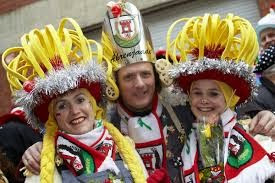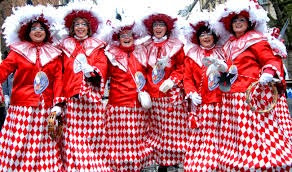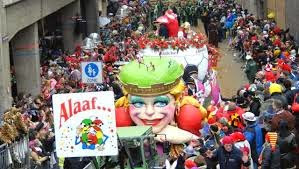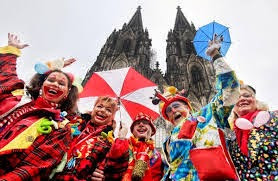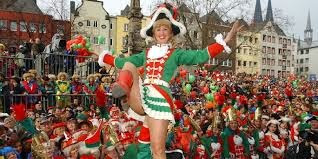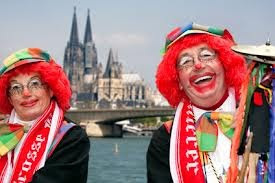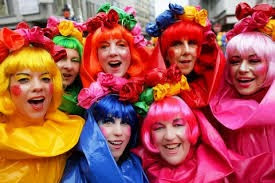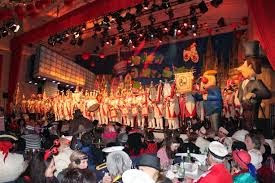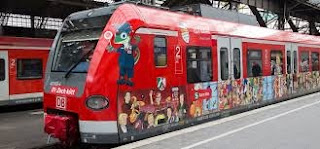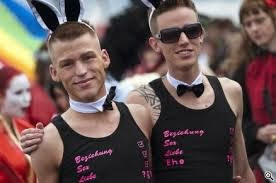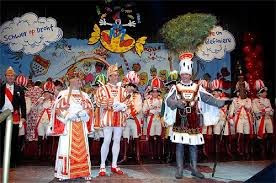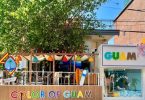Alaaf! Carnival in Cologne is something every visitor, tourist, and business traveler to Germany should plan to experience. It’s not only a tourism event, but the biggest local festival in this famous city with the gigantic Cologne Cathedral, and this city on the Rhine River. Participants treat strangers like close friends during this one week event. Beer, music, dancing, and non-stop fun – it’s what the Carnival in Cologne is about.
The Cologne Triumvirate consists of the Prince, Peasant, and Virgin. It is stipulated by the carnival societies which belong to the “Cologne Carnival Festival Committee.” The Prince, “His Madness,” is the highest representative of the Cologne Carnival and thereby the head of the Triumvirate. The Peasant, also called “His Heftiness,” is an expression of the pugnacity of the old imperial city of Cologne. Sword and threshing flail are symbols of his pugnacity and loyalty to the empire. He also carries the city keys as keeper of the city. The Virgin, “Her Loveliness,” symbolizes the protective mother Colonia. She wears an “able-bodied” crown.
This and her virginity symbolize the impregnability of the City of Cologne.
The Virgin in the Cologne Triumvirate is traditionally portrayed by a man.
The Cologne Carnival is among the world’s largest and most well-known
carnival celebrations. It is also called “Fastelovend” or “Fasteleer” in
dialect.
Other famous German Carnivals are ongoing at the same time in competing cities like Duesseldorf and Mainz.
The carnival session or the “Fifth Season” is officially opened on the “Eleventh in the Eleventh”, 11 November, at “eleven minutes past
Kölsch is language, attitude towards life and beverage. The local beer, “Kölsch”, is a top-fermented beer that flows like water, especially in the carnival season.
The Cologne Tourist office explains Carnival like this:
Costuming
The Cologne Carnival is a festival of costumes. The motto is the more
colorful the better. Hooped shirts, little hats and false noses are everywhere.
Decorated with make-up and a few paper streamers, you will be immediately and gladly accepted in the ranks of costumed revellers. You should choose a warm costume for celebrating outdoors, whereas a slightly scantier costume is more comfortable for the carnival
celebration in the pubs. Outlandish and self-made costumes are always
the nicest in this connection.
Bützje In the Cologne Carnival, a “Bützje” is a harmless peck on the cheek, an expression of joy and sympathy. A “Bützje” remains noncommittal, commits you to nothing and is therefore also dispensed to many people.
Kamelle – Strüßje If “Strüßjer” (small bouquets of flowers) and
“Kamelle” (carnival sweets such as candies, chocolate and pralines) are distributed to female spectators during the parades, the parade participants say with a wink: “Doför krije ich och e Bützje” (for that I also get a little kiss)
Kölle Alaaf The exclamation “Kölle Alaaf” is the Kölsch dialect
battle cry that should by no means be confused with “Helau”, because
this is the battle cry of revellers in Mainz or Düsseldorf.
“Kölle Alaaf” was documented in writing for the first time in 1635.
The word “Alaaf” stems from the old Cologne expression “all af” and
essentially means “Cologne above all (others)!” “Kölle Alaaf” only became the familiar battle cry of the Crazy Days as the carnival has been presented since 1823 in its altered form and increasingly conquered the street and the general public.
Where is something going on?
After the parades, the celebrating shifts to the pubs, bars and
brew-houses. There revellers sway, drink, sing and laugh until the early
morning. Depending on the weather situation or crowd of people, long
waiting queues in front of the doors can come about.
Particularly popular “Veedel”
(city districts) are:
· Kwartier Latäng/Zülpicher Str.
· Südstadt/Chlodwigplatz
· Nippes/Wilhelmplatz
· Altstadt
· Eigelstein
· Sülz/Gottesweg
Women‘s Carnivals Day
The official Street Carnival on Women’s Carnival Day (Kölsch:
Wieverfastelovend) starts at “11 minutes past 11 o’clock”. The main
event with the Triumvirate and the Lord Mayor of Cologne takes place at
the Old Market.
The equestrian carnival corps known as “Reiter-Korps Jan von Werth von
1925 e. V.” traditionally organises its “Spell ahn d’r Vringspooz” (“Play at Severinstorburg”) on Women’s Carnival
Day: at 2:30 in the afternoon the corps re-enacts the legend of “Jan un
Griet” on the square in front of the Torburg (fortified gate) at Chlodwigplatz.
After that the equestrian corps moves to the Old Market.
Carnival Friday
In addition to the many traditional sessions taking place on Carnival
Friday, about 1,500 revellers from carnival groups representing the
“Veedelszöch” (district parade) meet in the afternoon in their costumes of the last session (the new costumes are first presented on Sunday) for the converging march into the Cologne city centre. In the process, the participating groups move from the surrounding squares to the Old Market.
Carnival Saturday
A special Cologne morning get-together starts at 10:30 for the
Funkenbiwak (bivouac event) of the “Roten Funken” (“Red Sparks”)
carnival corps at Neumarkt (New Market).
Smaller parades start in numerous districts in the afternoon.
The Geisterzug (Ghost Parade) – a mixture of carnival parade and
political demonstration event – takes place in the evening. The Ghost
Parade came into being in its current form in 1991 as an “anti-Golf War
parade”. Since the Rose Monday
Parade in Cologne was cancelled due to the war, demonstrators and carnival revellers united and marched together through the Cologne city centre. In the evening there are numerous costume balls.
Carnival Sunday
The big day of families: since 1952, the “Schull- und Veedelszöch”
have marched through Cologne as a collective parade. About 50 cologne
schools take part in the school parade known as “Schullzöch”, whereas
about 50 clubs representing groups of regulars and districts also participate in the district parade known as “Veedelszöch”. Together they attract about 250,000 visitors. The parade starts at 11 past 11 o’clock at Chlodwigplatz in the Südstadt district and roughly takes the same route as the Rose Monday Parade the next day.
The best “foot and wagon groups” from the “Veedelszöch” are awarded
prizes and allowed to take part in the Rose Monday Parade.
Rose Monday
Rose Monday is the highlight and embodiment of the Cologne
Carnival. Over one million people line the route of the Rose Monday Parade that moves from Severinstorburg
through the Cologne city centre.
More than 12,000 participants with wagons and horses, pedestrian
groups and bands march in the singing and resounding “Zoch” (parade)
through the city centre, which is cordoned off on a large scale. The
parade disbands on Mohrenstraße and the surrounding streets.
Carnival Tuesday
On the last day of the carnival session, carnival revellers celebrate once again in their districts with more parades on Veilchendienstag (Violet Tuesday).
The largest carnival parades take place in the Köln-Mülheim, Köln-Nippes
and Köln-Ehrenfeld districts.
Before everyday life resumes on Ash Wednesday, the “Nubbel” is burned
or buried amidst wailing on Carnival Tuesday at midnight in many sites
in the city. The Nubbel is a straw doll that serves as a scapegoat for
all transgressions which fun-loving Cologne residents have committed in
the Fifth Season.
Ash Wednesday
As the old treasury of songs proclaim, everything is over on Ash Wednesday. Nevertheless, most carnival societies meet once again
on this day, but unadorned and in normal clothing, for the traditional
fish meal to start Lent.
Catholics in Cologne go to early mass and receive the traditional sign of the cross with ashes there.
(eTN): Social Jeck: Carnival in Cologne 2015 | re-post license | post content


